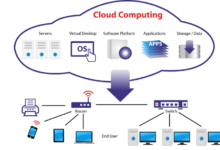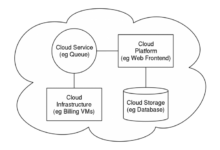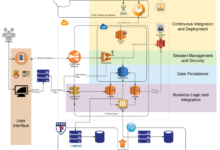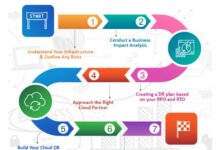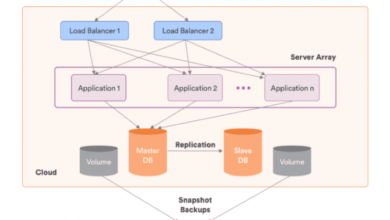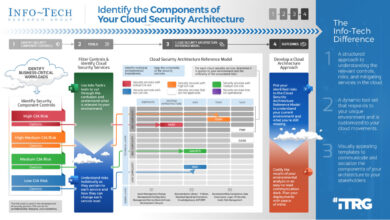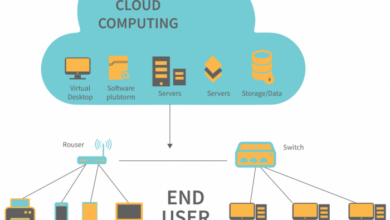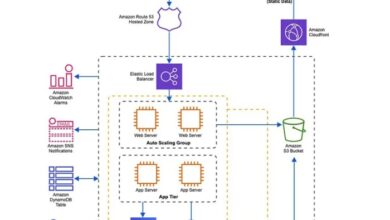Unveiling Cloud Architecture Diagrams: The Key to Performance Optimization and Beyond
In the realm of cloud computing, performance optimization reigns supreme. Enter cloud architecture diagrams—the unsung heroes that empower organizations to visualize, optimize, and transform their cloud infrastructure for peak performance. These visual representations serve as blueprints for building scalable, resilient, and cost-effective cloud solutions.
From identifying bottlenecks to planning for future growth, cloud architecture diagrams are indispensable tools for architects, engineers, and decision-makers alike. Join us as we delve into the intricacies of cloud architecture diagrams and discover how they can unlock the full potential of your cloud deployments.
Performance Optimization

Cloud architecture diagrams provide a visual representation of the infrastructure and services involved in a cloud computing environment. These diagrams can be used to optimize performance by identifying bottlenecks and areas for improvement.
Cloud architecture diagrams can help optimize performance in a number of ways. First, they can help identify bottlenecks in the system. By understanding the flow of data and the relationships between different components, it is possible to identify points where data is being slowed down or where there is a risk of congestion.
Examples of Performance Metrics
Some common performance metrics that are used in cloud architecture diagrams include:
- Latency: The amount of time it takes for a request to be processed.
- Throughput: The number of requests that can be processed in a given amount of time.
- Utilization: The percentage of time that a resource is being used.
- Errors: The number of errors that occur during a given period of time.
By tracking these metrics, it is possible to identify areas where performance can be improved.
Identifying Bottlenecks and Areas for Improvement
Cloud architecture diagrams can also be used to identify areas for improvement. By understanding the flow of data and the relationships between different components, it is possible to identify opportunities to improve efficiency or reduce costs.
For example, a cloud architecture diagram might reveal that a particular component is being underutilized. This could be an opportunity to consolidate resources or to move the component to a different location.
Scalability and Elasticity
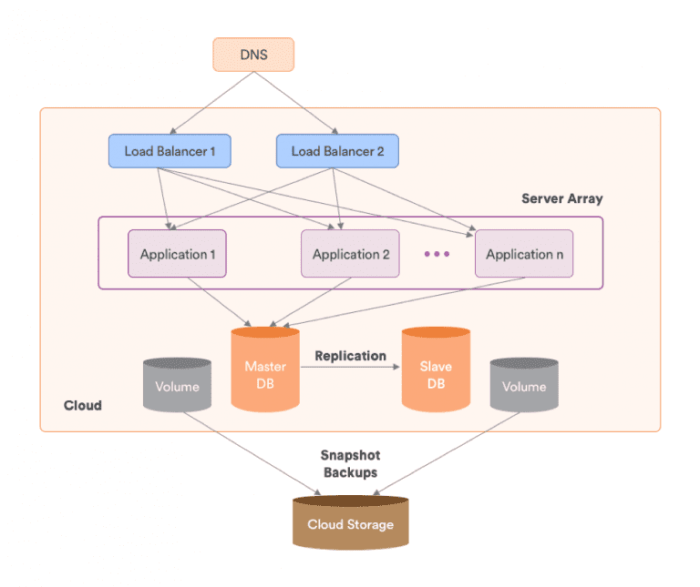
Cloud architecture diagrams provide a visual representation of how a cloud-based system can scale and adapt to changing demands. They help architects and engineers plan for future growth and ensure that the system can handle increased traffic or workload without compromising performance.
Planning for Future Growth and Demand
Cloud architecture diagrams help stakeholders understand how the system can scale horizontally or vertically to meet future growth and demand. They can also help identify potential bottlenecks and areas where the system may need to be reinforced to ensure optimal performance.
Examples of Cloud Architecture Diagrams
There are various types of cloud architecture diagrams that illustrate scalability and elasticity concepts. Some common examples include:
-
-*Tiered Diagrams
These diagrams show the different tiers of a cloud-based system, such as the application tier, database tier, and storage tier. They illustrate how each tier can be scaled independently to meet specific performance requirements.
-*Component Diagrams
These diagrams show the individual components of a cloud-based system and how they interact with each other. They can be used to identify potential bottlenecks and areas where the system can be optimized for better performance.
-*Deployment Diagrams
These diagrams show how a cloud-based system is deployed across multiple servers or cloud regions. They can be used to plan for disaster recovery and ensure that the system can continue to operate even if one or more components fail.
Cost Optimization

Cloud architecture diagrams play a pivotal role in optimizing costs associated with cloud deployments. By visualizing the cloud infrastructure, resource allocation, and application architecture, organizations can identify areas where costs can be reduced and implement strategies to achieve cost-effective cloud solutions.
Through cloud architecture diagrams, organizations can analyze various cost-saving strategies, such as:
- Rightsizing Resources: Diagrams help identify underutilized or overprovisioned resources, enabling organizations to optimize resource allocation and reduce costs.
- Leveraging Spot Instances: Diagrams can assist in identifying workloads suitable for spot instances, which offer significant cost savings compared to on-demand instances.
- Optimizing Storage Costs: Diagrams help visualize storage usage and identify opportunities for data archiving, compression, or migration to lower-cost storage tiers.
- Automating Resource Management: Diagrams can guide the implementation of automation tools that dynamically adjust resource allocation based on demand, reducing idle resources and associated costs.
Cost Allocation and Chargeback
Cloud architecture diagrams facilitate the implementation of cost allocation and chargeback mechanisms. By visualizing the resource consumption of different departments or projects, organizations can accurately allocate costs and ensure fair billing practices. This transparency promotes cost awareness and encourages responsible resource utilization.
Security and Compliance
Cloud architecture diagrams play a crucial role in ensuring security and compliance in cloud environments. They provide a visual representation of the security controls and measures implemented to protect data, applications, and infrastructure in the cloud.
These diagrams help stakeholders understand the overall security posture of the cloud environment and identify potential vulnerabilities or areas for improvement. Moreover, they facilitate communication and collaboration among security teams, architects, and compliance officers.
Security Best Practices
Cloud architecture diagrams that illustrate security best practices typically include the following elements:
- Network Segmentation: Diagrams should depict how the cloud environment is segmented into logical networks, with appropriate firewall rules and access control mechanisms in place.
- Encryption: Diagrams should show how data is encrypted at rest and in transit, using industry-standard encryption algorithms and protocols.
- Identity and Access Management: Diagrams should illustrate how user identities are managed and how access to resources is controlled, including multi-factor authentication and role-based access control.
- Security Monitoring and Logging: Diagrams should include components responsible for security monitoring, log collection, and analysis, enabling real-time detection and response to security incidents.
- Compliance Reporting: Diagrams should demonstrate how the cloud environment is configured to meet regulatory requirements and industry standards, including the generation of compliance reports.
Regulatory Requirements and Industry Standards
Cloud architecture diagrams play a critical role in meeting regulatory requirements and industry standards, such as:
- PCI DSS: Payment Card Industry Data Security Standard (PCI DSS) requires organizations that handle credit card data to implement specific security measures. Cloud architecture diagrams can demonstrate compliance with PCI DSS requirements.
- HIPAA: Health Insurance Portability and Accountability Act (HIPAA) mandates the protection of patient health information. Cloud architecture diagrams can illustrate how healthcare organizations comply with HIPAA regulations.
- GDPR: General Data Protection Regulation (GDPR) governs the processing of personal data in the European Union. Cloud architecture diagrams can help organizations demonstrate compliance with GDPR requirements.
High Availability and Disaster Recovery
Cloud architecture diagrams are essential tools for designing and implementing high availability and disaster recovery strategies. They provide a visual representation of the cloud infrastructure, including the components, their interconnections, and the data flow. This enables architects and engineers to identify potential single points of failure, design redundancy and failover mechanisms, and plan for disaster recovery scenarios.
Examples of Cloud Architecture Diagrams for High Availability and Disaster Recovery
- Active-Passive Failover: This diagram shows two identical instances of an application running in different regions. If one instance fails, the other instance takes over automatically, ensuring high availability.
- Active-Active Load Balancing: This diagram shows multiple instances of an application running in different regions. A load balancer distributes traffic across these instances, ensuring scalability and high availability.
- Disaster Recovery Site: This diagram shows a secondary data center or cloud region that is used to recover data and applications in the event of a disaster at the primary site.
Role of Cloud Architecture Diagrams in Ensuring Business Continuity and Minimizing Downtime
Cloud architecture diagrams play a crucial role in ensuring business continuity and minimizing downtime by:
- Identifying Single Points of Failure: Diagrams help identify components that can cause a single point of failure, allowing architects to design redundancy and failover mechanisms.
- Planning for Disaster Recovery: Diagrams help plan for disaster recovery scenarios by identifying critical systems and data, and designing recovery procedures.
- Improving Communication and Collaboration: Diagrams facilitate communication and collaboration among architects, engineers, and operations teams, ensuring that everyone has a clear understanding of the high availability and disaster recovery architecture.
Data Management and Analytics
Cloud architecture diagrams provide a comprehensive visualization of the infrastructure, components, and processes involved in efficient data management and analytics. These diagrams illustrate how data is stored, processed, and analyzed to derive valuable insights for decision-making and business growth.
Cloud architecture diagrams play a crucial role in optimizing data-driven decision-making and business insights. By providing a clear understanding of the data landscape, organizations can identify inefficiencies, optimize data pipelines, and implement strategies to leverage data for competitive advantage.
Data Storage and Retrieval
Cloud architecture diagrams depict the various data storage options available in the cloud, including object storage, block storage, and relational databases. These diagrams illustrate how data is distributed across multiple servers and regions for redundancy and high availability. They also show how data is retrieved efficiently using appropriate protocols and technologies.
Data Processing and Analytics
Cloud architecture diagrams illustrate the data processing and analytics pipelines used to transform raw data into actionable insights. These diagrams show the sequence of data processing steps, including data ingestion, cleansing, transformation, and analysis. They also depict the tools and technologies used for data processing, such as Apache Hadoop, Spark, and machine learning algorithms.
Data Visualization and Reporting
Cloud architecture diagrams showcase the mechanisms used to visualize and report data insights to stakeholders. These diagrams illustrate how data is presented in dashboards, reports, and other visual formats. They also show how data is integrated with business intelligence tools and applications to facilitate decision-making.
Integration and Interoperability
Cloud architecture diagrams play a crucial role in promoting integration and interoperability among various cloud services and applications. They provide a visual representation of how different components interact, enabling architects and developers to understand and manage the complexities of a cloud-based ecosystem.
By illustrating integration patterns and data exchange mechanisms, cloud architecture diagrams facilitate the creation of seamless and interconnected cloud environments. This enables applications to communicate and share data efficiently, leading to improved performance, agility, and scalability.
Integration Patterns
- Point-to-Point Integration: This involves direct connections between two or more cloud services or applications. It is simple to implement but can become complex as the number of connections grows.
- Enterprise Service Bus (ESB): An ESB acts as a central hub for message routing and transformation. It simplifies integration by decoupling applications from each other, making it easier to add or remove services without affecting the overall architecture.
- Application Programming Interfaces (APIs): APIs provide a standardized way for applications to communicate with each other. They enable loose coupling, allowing applications to integrate easily and share data and functionality.
Data Exchange Mechanisms
- Message Queuing: Message queuing systems allow applications to communicate asynchronously. Messages are stored in a queue and processed by the receiving application when it is ready.
- Event-Driven Architecture: In an event-driven architecture, applications respond to events generated by other applications or services. This enables real-time communication and data processing.
- Data Synchronization: Data synchronization ensures that data is consistent across multiple systems. This is important for applications that require real-time access to up-to-date data.
Creating Seamless Cloud Ecosystems
Cloud architecture diagrams are essential for creating seamless and interconnected cloud ecosystems. By providing a comprehensive view of the relationships between different components, they enable architects and developers to identify and address potential integration challenges early on. This helps to ensure that applications can communicate and share data efficiently, leading to improved performance, scalability, and agility.
Final Conclusion
Cloud architecture diagrams are not mere static representations; they are dynamic tools that evolve alongside your cloud infrastructure. Regularly revisiting and updating these diagrams ensures that your cloud architecture remains aligned with your evolving business needs and technological advancements. Embrace the power of cloud architecture diagrams to unlock a world of possibilities, optimize performance, and drive your organization towards success.
